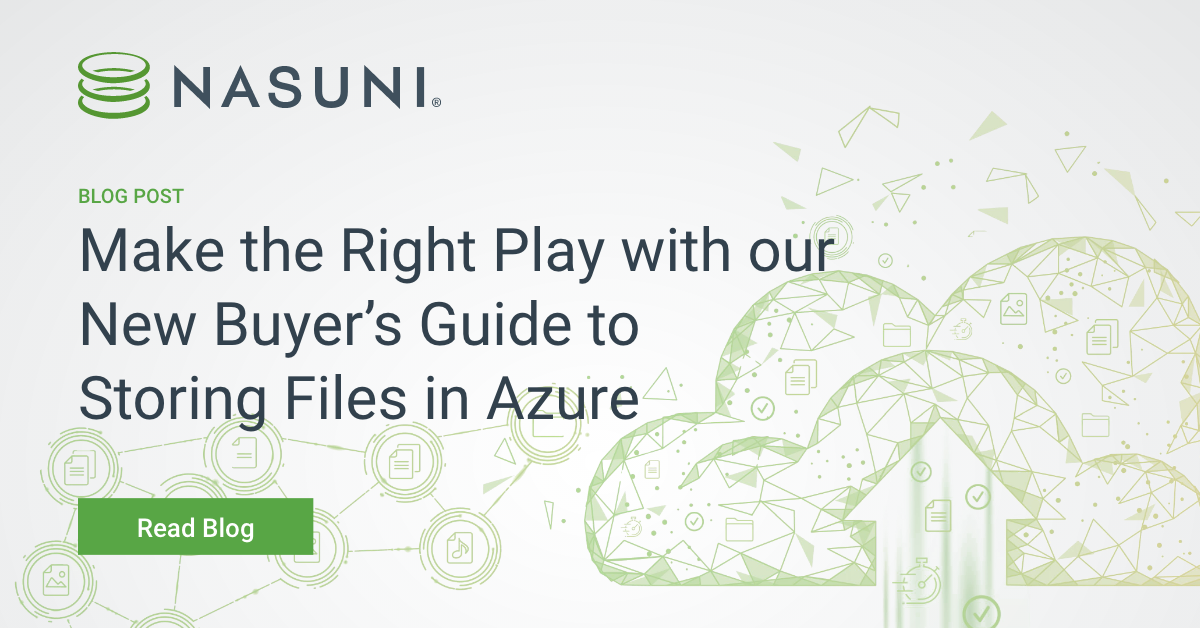Make the Right Play with Our New Buyer’s Guide to Storing Files in Azure
February 13, 2023 | Tom Rose
I’ve coached hundreds of companies through the process of assessing their options for storing files and unstructured data management in Microsoft Azure, and one thing is absolutely clear: selecting the right file data storage solution is confusing and time-consuming. Microsoft Azure is a great place to start if you’re looking to replace aging Windows File Servers, end-of-service StorSimple appliances, or costly, data center-confined Network Attached Storage (NAS) from Dell or NetApp. But then you are presented with three different file storage options within Azure. All three – Azure Files, Azure NetApp Files, and Nasuni with Azure Blob object storage – sound similar. All three count toward your Microsoft Azure Consumption Commitment (MACC). And all three are available in the Azure Customer Portal.
So how can an IT leader be sure you’re taking your best shot? I hope our new Buyer’s Guide is a good place to start.
Why did we create this Buyer’s Guide?
The purpose of this guide is to analyze and explain the different options and help you determine which one is the best fit for you. Their names might sound similar, but the file storage solutions in Azure are designed for different organizations, use cases, and workloads, and each is different in terms of architecture, scalability, features, and costs. These details are essential to consider. Our Buyer’s Guide aims to provide a quick-but-thorough resource for you to decide which Azure storage solution is best for your requirements and organization.
How is it going to help your IT team and your business?
Spending months evaluating and testing a product only to find out it isn’t the right technical fit or cost-effective doesn’t make sense. Our Buyer’s Guide is designed to save you considerable time and money by comprehensively comparing the three file storage solutions in Azure to help you avoid unqualified proofs of concept or, worse, surprises in your monthly cloud bills.
What can you find in the guide?
The guide is designed to be the ultimate handbook for fully understanding your file storage options in Azure. It breaks down Azure Files, Azure NetApp Files, and Azure Blob with Nasuni based on the criteria that matter most:
- Use cases
- Pricing
- Purchase and Deployment
- File Sharing and Access Capabilities
- Security and Data Protection Capabilities
- Scalability and Performance
You can access the guide here. Need some additional coaching with your unstructured data management? We are always happy to schedule a one-on-one consultation. As a top Azure partner that has stored more than 100 PB of customer file data in Azure Blob object storage, you won’t find a more qualified expert on Azure storage outside of Microsoft itself.
Jim Liddle shares how Nasuni is educating customers on how to create customized Microsoft Copilot experiences with AI business tools that use a customer’s unstructured data set to unlock further business insights and revenue streams.
Lance Shaw shares insights from Gartner’s ‘Market Guide for Hybrid Cloud Storage’ as well as their projections for the market over the next few years.
Anne Blanchard shares trends and takeaways from Gartner’s Infrastructure, Operations Cloud Strategies conference around the push for enterprise organizations to move to a hybrid cloud storage platform.


